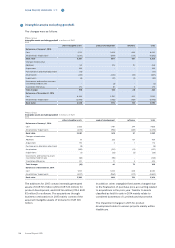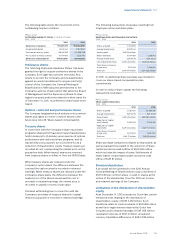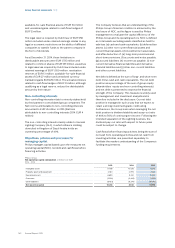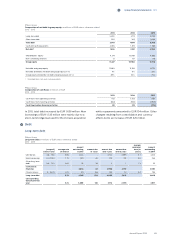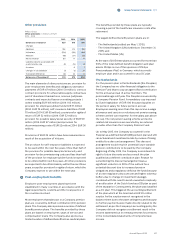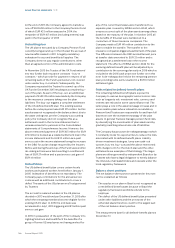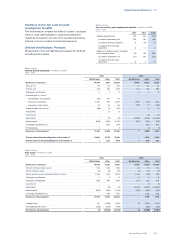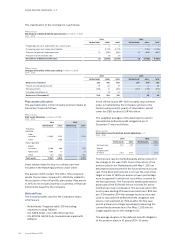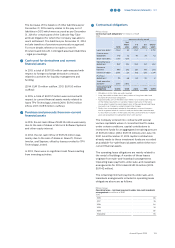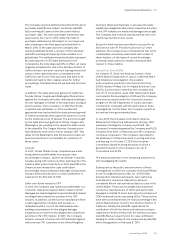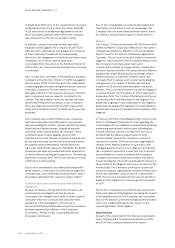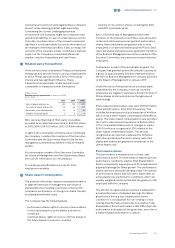Philips 2015 Annual Report Download - page 148
Download and view the complete annual report
Please find page 148 of the 2015 Philips annual report below. You can navigate through the pages in the report by either clicking on the pages listed below, or by using the keyword search tool below to find specific information within the annual report.Group nancial statements 12.9
148 Annual Report 2015
At the end of 2013 the Company agreed to transfer a
one-o EUR 600 million to the Company Pension Fund
of which EUR 433 million was paid in 2014; the
remainder of EUR 167 million (excluding interest) was
paid in the rst quarter of 2015.
United Kingdom
The UK plan is executed by a Company Pension Fund
currently being wound up. In the UK plan the accrual of
new benets ceased in 2011. A legally mandatory
indexation for accrued benets still applies. The
Company does not pay regular contributions, other
than an agreed portion of the administration costs.
In November 2015 the Trustee of the UK Fund entered
into two further bulk insurance contracts - buy-in
contracts - which provide for payment in respect of all
remaining parts of the Fund’s pensioners not covered
under earlier buy-in contracts. Subsequently, the
Company requested the Trustee for a wind-up of the
UK Fund in December 2015 resulting in a complete buy-
out of the plan. As part of the buy-out, an additional
payment of EUR 305 million was made by the Company
to the insurance company taking over the plan
liabilities. The buy-out triggers a complete settlement
of the UK dened benet plan. The existing surplus
before the extra payment was EUR 375 million. As this
surplus was not recognized in the balance sheet, due to
the asset ceiling test, per the Company’s accounting
policy the Company did not recognize this as a
settlement result in the income statement but in
remeasurements for pensions in the Consolidated
statements of Comprehensive Income. However, the
above mentioned payment of EUR 305 million for EUR
274 million is booked as a related settlement loss in the
income statement and for EUR 31 million as a past
service cost in the income statement being the increase
in the DBO for a plan change required by the Insurers.
Before and during the wind up of the Fund several other
de-risking actions were held resulting in a settlement
loss of EUR 27 million and a past service cost gain of
EUR 14 million.
United States
The US dened benet plan covers certain hourly
workers and salaried workers hired before January 1,
2005. Indexation of benets is not mandatory. The
Company pays contributions for the annual service
costs as well as additional contributions to cover a
decit. The assets of the US plan are in a Trust governed
by Trustees.
The accrual for salaried workers in the US plan as
decided in 2013 would end per December 31, 2015 after
which the remaining members become eligible for the
existing US DC plan. In 2015 the end date was
accelerated to July 1, 2015 triggering a EUR 1 million past
service cost gain.
In 2015 in preparation of the split of the Company into
Lighting Solutions and HealthTech the benets of a
group of former US employees not having worked for
any of the current businesses were transferred to a
separate plan covered by ERISA section 4044, which
ensures a correct split of the plan assets among others
based on the maturity of the plan. In October 2015 all
the benets of this plan were transferred to a
consortium of three insurance companies. The
Company made a EUR 141 million contribution to the
plan to enable the transfer. The transfer to the
insurance companies triggered a settlement of the plan.
The dierence between the DBO and settlement price
at transfer date amounted to EUR 33 million and is
recognized as a settlement loss in the income
statement. The eects of ERISA section 4044 for the
surviving dened benet plan will be adjusted by a
contribution to the surviving plan early in 2016 which is
included in the 2016 cash projection further on in this
note. A de-risking action held in the remaining pension
plan providing lump sums resulted in a EUR 6 million
settlement gain.
Risks related to dened-benet plans
The remaining dened benet plans expose the
Company to various demographic and economic risks
such as longevity risk, investment risks, currency and
interest rate risk and in some cases ination risk. The
latter plays a role in the assumed wage increase and in
some smaller plans where indexation is mandatory.
Pension fund Trustees are responsible for and have full
discretion over the investment strategy of the plan
assets. In general Trustees manage pension fund risks
by diversifying the investments of plan assets and by
(partially) matching interest rate risk of liabilities.
The Company has an active de-risking strategy in which
it constantly looks for opportunities to reduce the risks
associated with its dened benet plans. Liability
driven investment strategies, lump sum cash-out
options, buy-ins, buy-outs and the above mentioned
2015 change to DC for the Dutch plan and the other
settlements are examples of that strategy. The larger
plans are either governed by independent Boards or by
Trustees who have a legal obligation to evenly balance
the interests of all stakeholders and operate under the
local regulatory framework.
Balance sheet positions
The net balance sheet position presented in this note
can be explained as follows:
• The surplus in our plan in Brazil is not recognized as
a net dened benet asset because in Brazil the
regulatory framework prohibits refunds to the
employer.
• The decit of the US dened benet plan presented
under other liabilities and the provisions of the
unfunded plans therefore count for the largest part
of the net balance sheet position.
The measurement date for all dened-benet plans is
December 31.


